Are you in search of a backup generator for your home? Before you buy one, it’s important to understand the power requirements of the electrical appliances and tools you need to keep running during a power outage.
I have great news for you! Our team here at Generatorist has helped over 600,000 people find the information they need about generators and we’re here to help you too.
These tables & charts will help you determine the size and power of the generator you’ll need as a backup source of power. Be sure to check the actual wattage consumption of each appliance and power tool in your home separately.
Our information is sourced from reputable government websites and popular generator manufacturers such as Honda, Generac, and Yamaha, as well as merchants like Lowe’s, Sears, and Home Depot. We add new appliances and update the numbers on a regular basis to make this the most comprehensive resource out there.
Essential Appliances
| Household Appliances | Rated (Running) Watts | Additional Surge Watts |
|---|---|---|
| Evaporative AC | 2,600 W | 0 W |
| Heat Pump | 4,700 W | 4,500 W |
| Humidifier (13 Gal.) | 175 W | 0 W |
| Electric Water Heater | 4,000 W | 0 W |
| Well Water Pump (1/2 HP) | 1,000 W | 2,100 W |
| Window AC (10,000 BTU) | 1,200 W | 3,600 W |
| Window AC (12,000 BTU) | 3,250 W | 9,750 W |
| Central AC (10,000 BTU) | 1,500 W | 4,500 W |
| Central AC (24,000 BTU) | 3,800 W | 11,400 W |
| Sump Pump (1/3 HP) | 800 W | 1,300 W |
| Sump Pump (1/2 HP) | 1,050 W | 2,150 W |
| Furnace Fan Blower (1/3 HP) | 700 W | 1,400 W |
| Furnace Fan Blower (1/2 HP) | 800 W | 2,350 W |
| Garage Door Opener (1/2 HP) | 875 W | 2,350 W |
| Light Bulb (Common) | 75 W | 0 W |
| Space Heater | 1,800 W | 0 W |
| Ceiling Fan | 60 W | 70 W |
| Dehumidifier | 240 W | 0 W |
| Tube Light (1500mm) | 22 W | 0 W |
| Night Light | 1 W | 0 W |
| Electric Heater (Fan) | 2,000 W | 1,000 W |
| Electric Thermal Radiator | 500 W | 0 W |
| Light Bulb (LED) | 9 W | 0 W |
| Electric Water Heater (Tankless) | 6,600 W | 2,200 W |
| Electric Water Heater (Immersion) | 3,000 W | 0 W |
| Oversink Water Heater (Hand Wash) | 3,000 W | 0 W |
| Central AC (40,000 BTU) | 6,000 W | 6,700 W |
Kitchen Appliances
| Household Appliances | Rated (Running) Watts | Additional Surge Watts |
|---|---|---|
| Toaster | 850 W | 0 W |
| Microwave | 1,000 W | 0 W |
| Refrigerator / Freezer | 700 W | 2,200 W |
| Coffee Maker | 1,000 W | 0 W |
| Electric Stove (8" Element) | 2,100 W | 0 W |
| Wine Cooler (18 Bottles) | 83 W | 0 W |
| Deep Freezer | 500 W | 1,500 W |
| Electric Can Opener | 170 W | 0 W |
| Dishwasher | 1,500 W | 1,500 W |
| Food Processor/Blender | 400 W | 0 W |
| Electric Kettle | 1,200 W | 3,000 W |
| Food Dehydrator | 800 W | 0 W |
| Fryer | 1,000 W | 0 W |
| Pressure Cooker | 700 W | 0 W |
| Rice Cooker | 200 W | 500 W |
| Slow Cooker | 160 W | 20 W |
| Steriliser | 650 W | 0 W |
| Water Dispenser | 100 W | 0 W |
| Sandwich Maker | 700 W | 300 W |
| Percolator | 800 W | 300 W |
| Electric Oven | 2,150 W | 0 W |
| Espresso Coffee Machine | 1,300 W | 200 W |
| Induction Hob (Per Hob) | 1,400 W | 400 W |
| Cooker Hood | 20 W | 10 W |
| Air Fryer | 1,500 W | 0 W |
| Water Filter & Cooler | 70 W | 30 W |
| Hot Water Dispenser | 1,200 W | 100 W |
| Side-by-Side Fridge | 800 W | 1,200 W |
| Modern Fridge (2001-2020) | 400 W | 600 W |
| Smart Fridge | 500 W | 750 W |
Laundry Appliances
| Household Appliances | Rated (Running) Watts | Additional Surge Watts |
|---|---|---|
| Clothes Dryer (Gas) | 700 W | 1,800 W |
| Clothes Dryer (Electric) | 5,400 W | 6,750 W |
| Hair Dryer | 1,250 W | 0 W |
| Iron | 1,200 W | 0 W |
| Washing Machine | 1,150 W | 2,250 W |
| Curling Iron | 1,500 W | 0 W |
| Electric Shaver | 15 W | 20 W |
| Vacuum Cleaner | 200 W | 200 W |
| Bathroom Towel Heater | 60 W | 90 W |
| Extractor Fan | 12 W | 0 W |
| Electric Shaver | 15 W | 5 W |
| Heated Bathroom Mirror | 50 W | 50 W |
| Steam Iron | 2,200 W | 300 W |
| Straightening Iron | 75 W | 300 W |
| Power Shower | 7,500 W | 10,500 W |
Entertainment Appliances
| Household Appliances | Rated (Running) Watts | Additional Surge Watts |
|---|---|---|
| Laptop | 50 W | 0 W |
| Stereo | 450 W | 0 W |
| Television (22" LED) | 17 W | 0 W |
| Television (49" LED) | 85 W | 0 W |
| Television (82" LED) | 230 W | 65 W |
| Television (CRT) | 500 W | 0 W |
| VCR / DVD Player | 100 W | 0 W |
| Video Game System | 40 W | 0 W |
| Monitor | 200 - 250 W | 0 W |
| Home Internet Router | 5 W | 15 W |
| Home Phone | 3 W | 5 W |
| Playstation 4 | 85 W | 5 W |
| Nintendo Switch AC Adapter | 7 W | 33 W |
| Amazon Echo | 3 W | 0 W |
| Amazon Echo Show | 2 W | 2 W |
| Apple TV | 3 W | 3 W |
| Computer Monitor | 25 W | 5 W |
| Desktop Computer | 100 W | 350 W |
| Xbox One | 50 W | 60 W |
| Mi Box | 5 W | 2 W |
| Set Top Box | 27 W | 3 W |
| Home Sound System | 95 W | 0 W |
| Guitar Amplifier | 20 W | 10 W |
| AV Receiver | 450 W | 0 W |
Other Appliances
| Household Appliances | Rated (Running) Watts | Additional Surge Watts |
|---|---|---|
| Clock Radio | 50 - 200 W | 0 W |
| Fax | 60 - 80 W | 0 W |
| Printer (Laser) | 600 W | 200 W |
| Printer (Inkjet) | 20 W | 10 W |
| Security System | 500 W | 0 W |
| Garage Door Opener (1/2 HP) | 875 W | 2,350 W |
| Copy Machine | 1,600 W | 0 W |
| Cell Phone Battery Charger | 25 W | 0 W |
| Outdoor Light String | 250 W | 0 W |
| Electric Mower | 1,500 W | 0 W |
| Paper Shredder | 200 W | 220 W |
| Projector | 220 W | 270 W |
| Scanner | 10 W | 18 W |
| Electric Trimmer | 300 W | 500 W |
| Treadmill | 280 W | 900 W |
| Tablet Charger | 10 W | 5 W |
| Sewing Machine | 70 W | 10 W |
| Air Purifier | 25 W | 5 W |
| DAB Mains Radio | 5 W | 4 W |
| EV Home Charger | 1,600 W | 1,800 W |
| Electric Blanket | 200 W | 0 W |
| Electric Doorbell Transformer | 2 W | 0 W |
| Water Feature | 35 W | 0 W |
| Fan (Pedestal) | 50 W | 10 W |
| Fan (Table) | 10 W | 15 W |
| Fan (Wall) | 45 W | 15 W |
| 2-Way Radio (12A) | 360 W | 0 W |
| 2-Way Radio (23A) | 840 W | 0 W |
| 2-Way Radio (35A) | 960 W | 0 W |
Printable Chart
Determining your
If you want to learn what electronic appliances will your generator run, you need to get ready to do some math. Don’t worry, it will be a very simple process of adding up several numbers.
To determine what appliances you can run on a 4000 watt generator at the same time, you need to follow these steps:
- List all electronic appliances in your home you want to keep running in the case you are out of power (here is a great list full of appliances you might use)
- Write information from their name tags on required running and starting watts into a table (see examples below)
- Then you need to add up all the running watts required to operate your appliances
- The next step is to find the item with the highest additional starting watts
- Then add this number to your total running watts
- The final number represents the amount of starting watts your generator needs to provide
Here is an example of how to calculate the wattage requirements for a generator:
We have decided that in case of a weather-caused blackout, we would need only essentials such as refrigerator with a freezer so our food will be safe, a lamp that will serve as an emergency light source, a small window AC unit to keep the temperature under control, a toaster, and a laptop.
| Selected Appliances | Rated (Running) Watts | Additional Starting Watts |
|---|---|---|
| Toaster | 850 W | 0 W |
| Refrigerator / Freezer | 700 W | 2,200 W |
| Laptop | 50 W | 0 W |
| Lamp (2 Lightbulbs) | 150 W | 0 W |
| Window AC (10,000 BTU) | 1,200 W | 3,600 W |
| TOTAL | 2,950 W | |
| 6,550 W |
As you can see in our example above, if we add up all running watts of our appliances we get the number 2,950 – so we are well within the 4,000 running watts limit (850 + 700 + 50 + 150 + 1,200 = 2,950).
However, we would need a generator that is capable of producing at least 6,550 surge (starting) watts to power all these appliances (2,950 + 3,600 = 6,550).
Just keep in mind that some electric appliances in your home may not have running watts provided on their data tags. If this is the case, you can estimate the running watts required thanks to the following formula:
Watts (W or kW) = Volts (V) x Amps (A)
Amps (A) = Watts (W or kW) / Volts (V)
So, as long as you have required Volts and Amps, you can easily convert them into an estimate of required running watts. Maybe you remember that this equation represents the Ohm’s law from High School physics.
Luckily, there is a device called “appliance load tester” that you can get to determine how many watts each your appliance takes. You can easily get one from Amazon and avoid all that physic´s equation.
You need to check each appliance / power tool in your home individually to see the precise wattage requirements. Feel free to check out the wattage requirements of the most popular household appliances, RV & camping appliances, or power tools for contractors here on Generatorist.
Further resources:
- List of Electric Appliances & Their Wattage Usage
- Appliance Energy Use Chart
- How Much Power Do Your Appliances Use?
- Power Consumption of Typical Household Appliances
- Just How Much Power Do Your Electronics Use When They Are ‘Off’?
- RV & Camping Appliances: Power Consumption
- Power Tools & Contractors Appliances: Wattage Requirements
- Choosing the Best Generator for Your Household
Looking for More Appliances & Their Wattage Usage?
About Generatorist

Matthew Gerther
Founder, Generator enthusiast
Our aim here at the Generatorist is to become the No. 1 resource for all things related to generators & your power needs. We have helped over 600,000 visitors with our tips, articles and reviews and we will help you as well.
Our work has been featured in many publications around the world – Yahoo.com, Telegram.com, PaylessPower.com, PopSci.com, TopTenReviews.com, TechRepublic.com, iRV2.com, ThePrepared.com, Renogy.com or ADT Solar. Generators are our passion, and we strive to provide the most reliable & most comprehensive information out there.



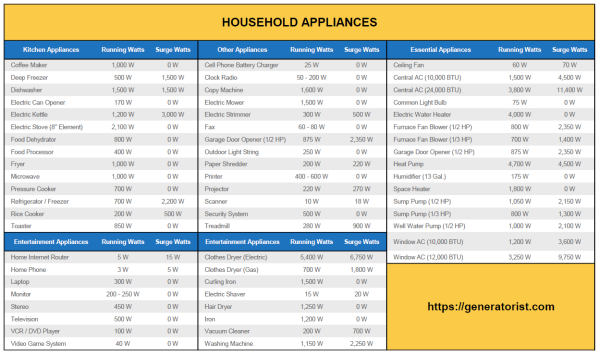
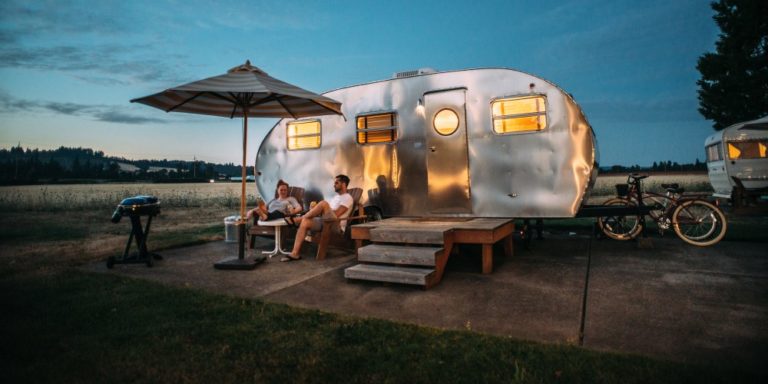

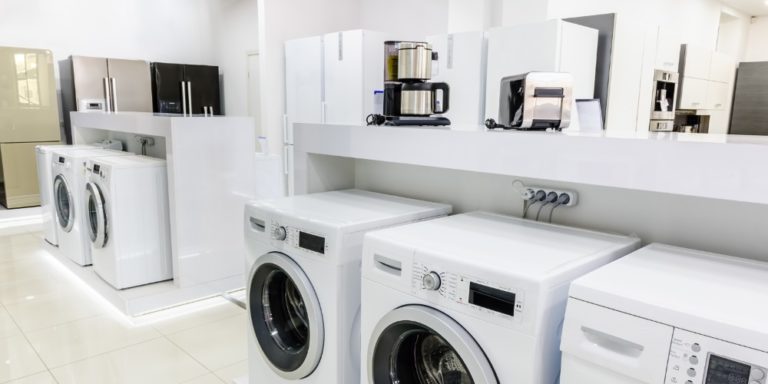
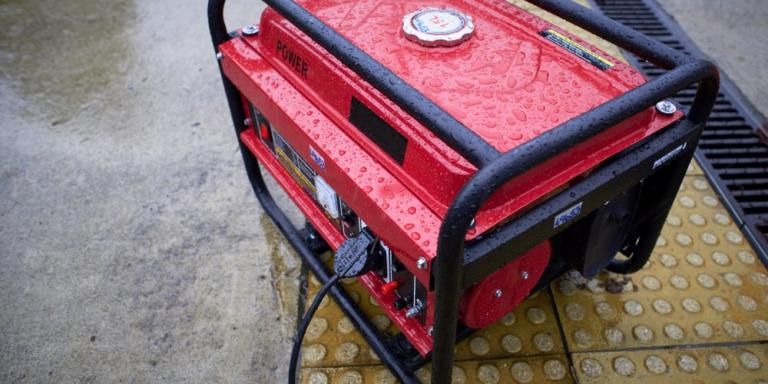
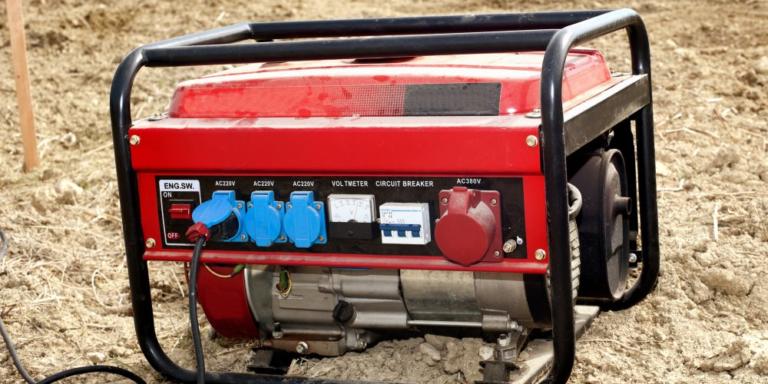
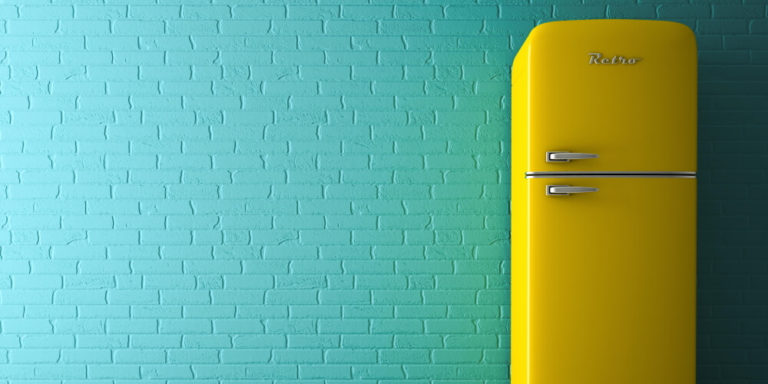

10 thoughts on “Power Consumption of Household Appliances”
great Info Thank you
would love to ask questions about living off the grid if you have knowledge in that area.
Thanks, Sandy
Could you please, explain how do you get 300W for a laptop?. My laptop specification shows 65W. Thank you
I am wanting to use a Ryobi 1200W petrol generator to charge a Nissan Leaf 2013 and cannot find a Safety load to allow this to work.
What do I need to add in to achieve Charging ?
My intent is to have a Reserve Power Supply for very long trips between Superchargers !!!
Yours in Faith
John S Croawell
Hey John, I think these 2 links might help you:
https://www.mynissanleaf.com/viewtopic.php?t=23899
https://www.mynissanleaf.com/viewtopic.php?t=13318
All the best,
Matthew
This is a great resource site. I’m actually looking at purchasing a battery backup power station to replace a gas powered generator. You might want to look at them. They’re very powerful, can run for a long time in many situations and with the addition of stand-alone solar panels could provide power for a long time during an outage. They are pricey, but not when compared to high end solutions like Generac installations. Personally I think a lot of people will opt for them since so many people don’t have the option of running a petrol based generator (apartments, condos, city-dwellers, etc.).
Thanks again for building such a useful site.
Thanks for the superb info.
Any thoughts on battery generators with solar recharging?
In addition to power I’d like to assess recharge times and panel hookups.
I assume your startup cost for a 40K BTU Central AC System is missing a leading 1 or it is very efficient at starting compared to the smaller units.
From your chart: Running/Starting Watts
Central AC (10,000 BTU) 1,500 W 4,500 W
Central AC (24,000 BTU) 3,800 W 11,400 W
Central AC (40,000 BTU) 6,000 W 6,700 W
Wattage on 12K window AC is incorrect. How could it use almost three times what a 10K uses. The correct amount is 15K.
Great info. After super typhoon mawar on Guam, i need to have emergency power. Power was out over a month. I have been through dozens of typhoons, about a dozen that were super typhoons. This site is a great source when considering on buying backup generator. Super typhoons that I would list here are Karen, Pamela, pongsona, mawar and dozens of other typhoons. Not thinking of leaving Guam.